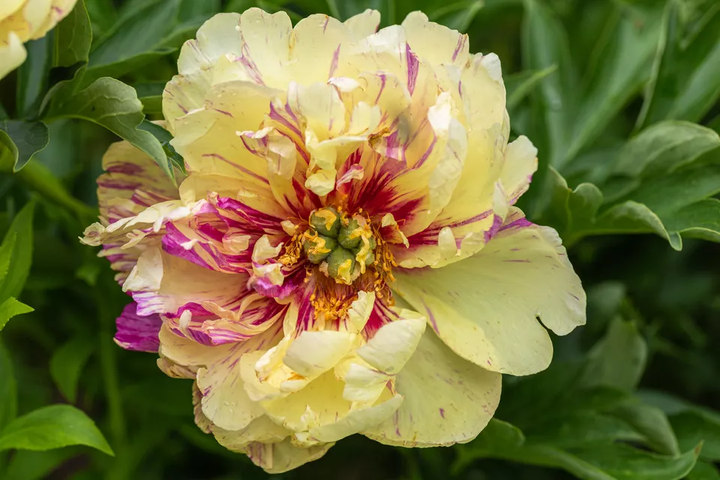Known as intersectional hybrids, the Itoh peony combines qualities from both of its parent plants: tree peonies and herbaceous peonies. As a result, they have enormous, long-lasting blooms and strong stems, as well as dark green, lush, deeply lobed foliage that lasts until autumn. Since they also have the mounded growth habit of herbaceous peonies, they’ll die back to the ground in the winter.
With flowers that can spread up to eight inches across and petals that encircle yellow stamens, Itoh peonies come in a variety of vibrant colors including coral, pink, red, and white as well as their signature yellow.

As with most peony species, these plants make beautiful additions to cut flower arrangements, and they are considered easy to grow, remarkably beautiful, and even have a fragrant lemon scent. They can often be found in perennial borders as well as mixed with other shrubs, but Itoh peonies also work as a stand-alone plant or in groups--even as hedges.
Named after Japanese botanist Toichi Itoh, who was the first to successfully cross a tree peony with a herbaceous peony in the 1940s, the Itoh peony became beloved for both its lush green foliage and giant beautiful blooms. It remains highly in demand to this day.
Botanical Name:
Paeoniaceae (peony)
Common Name:
Itoh peony
Plant Type:
Intersectional hybrid
Mature Size:
Three feet tall, four feet wide
Sun Exposure:
Full sun, part shade
Soil Type:
Rich, well-drained
Soil pH:
6-7
Bloom Time:
Late summer
Flower Color:
Yellow, coral, pink, red, white
Hardiness Zones:
3-8
Native Area:
Alaska, Canada
How to Grow Itoh Peony Plants
Itoh peonies are prolific bloomers—they can grow vigorously to three feet tall and four feet wide—and will grow a second set of blooms. Once they're established, they have an extended blooming period.
You can expect 30 blossoms the first year and up to 60 on a mature bush. Itoh peonies are also resistant to peony blight, and since they’ve inherited the tree peony’s strong stems, gardeners won’t have to worry about staking since they are unlikely to bend over in wind and rain.
They resemble tree peonies thanks to their vigorous, domed growth and large double flowers, and their dark green foliage is known to be largely disease resistant.
Light
The Itoh peony’s foliage will grow dense and healthy in full sun, but its flowers will typically last longer if they are exposed to some light shade.
Water
You'll want to water your Itoh peonies in spring as new growth emerges, provided there's no natural rainfall for more than two weeks. Water lightly twice a week, but avoid drowning the soil.
Soil
Be sure to plant Itoh peonies in rich, well-drained soil; they are sensitive to high levels of nitrogen.
Temperature and Humidity
Itoh peonies are known to be cold hardy. However, much like their tree peony parents, Itoh hybrids are primarily recommended for warmer climates (like southern California).
Fertilizer
When fertilizing your Itoh peonies in the spring and summer months, be sure to choose a fertilizer that contains a low level of nitrogen (such as 4-10-12). You’ll want to avoid fertilizing peonies in late summer to fall.
Potting and Repotting
Itoh peonies have large roots, so, when potting, be sure to choose a container that’s a minimum of 18 inches wide and deep. The pot should also have excellent drainage. Though they can tolerate some cold, it's recommended to move your container indoors for winter.
Propagating Itoh Peonies
Crown division is the traditional method of propagating all Itoh peonies.
Some Varieties of Itoh Peonies
Bartzella: Very large with bright yellow double blossoms and a slight red center stain; flowers have a slightly spicy scent
Keiko: Large, semi-double to double flowers; dark lavender-pink petals fade to a soft pink
Yankee Doodle Dandy: Semi-double to double blooms of deep pink with cream undertones; upright stems don't require any staking
Pruning
Itoh peonies can be deadheaded on an as-needed basis throughout the spring and summer months. In the fall, cut them about four to six inches from the soil level. Like herbaceous peonies, Itoh peonies will come back in the spring from the ground. In fall, you can divide Itoh peonies the same way you would divide herbaceous peonies.